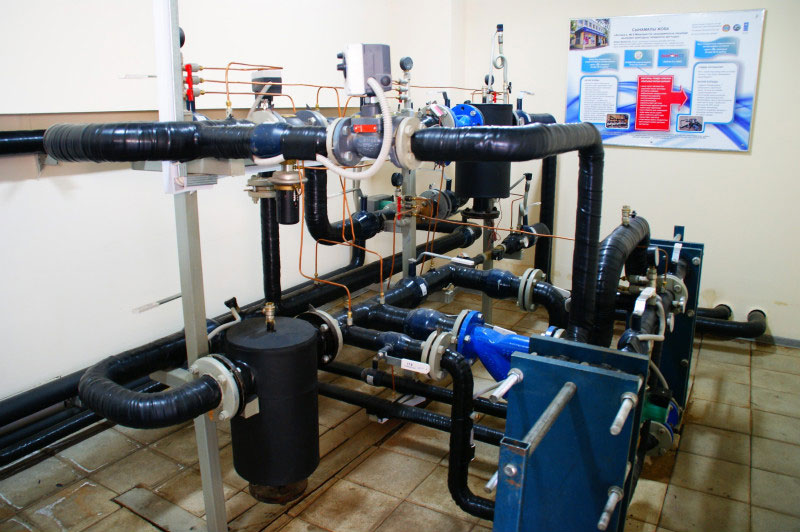ASTANA – The UN Development Programme and the Kazakh government have launched a five-year, $71.3 million project to generate and support Nationally Appropriate Mitigation Actions (NAMAs) for Low-carbon Urban Development in Kazakhstan. The NAMAs are expected to encompass investments in infrastructure, capacity building, awareness raising and technical assistance and reduce Kazakhstan’s greenhouse gas (GHG) emissions by 15 percent by 2020, a UNDP announcement about the project reads.

This heating substation, installed at a school in the city of Astana (by UNDPGEF Project – 2012-2013).
“The major idea is to help urban municipalities develop truly sustainable urban development plans and to help them devise fiscal instruments that are going to make these plans attractive to private investors,” explained Rassul Rakhimov, UNDP programme analyst and portfolio manager for the Energy and Environment Unit, on May 26. “This is an instrument that was developed under the UN Framework Convention on Climate Change to help developing countries develop more sustainable agendas. It is funded by a number of foundations, the largest being the Global Environmental Facility [GEF]. This particular project aims at sustainable development in cities,” Rakhimov said.
The NAMAs will address transport, energy supply, communal energy efficiency and waste management in 15 cities around Kazakhstan, Rakhimov said. The list is being devised by UNDP/GEF Projects Coordinator Alexander Belyi, who is looking for cities that are interested and that they have development plans in operation. “It was a surprise to us that some towns don’t really have development plans; they do not really think that they might want to change anything,” Rakhimov noted. “So we are targeting those that have both desire and capacity.”
Almaty is a priority city for the project, Rakhimov said. “Almaty would be logical to continue working in [because] we already have a project on transport, and it makes sense to just scale up and show that Almaty, despite being [Kazakhstan’s] biggest city, can also be the most advanced in sustainable development.” Almaty’s money, capacity for implementation and status as Kazakhstan’s informal entrepreneurial capital, with the concurrent investors, make it an appealing partner, Rakhimov said. The project has also received a great deal of attention from South Kazakhstan, he reported, and industrial North Kazakhstan also holds promising potential partners. The final list of cities will be completed by October, he said.
After the cities are chosen, UNDP/GEF experts will work with cities to define needs and goals, Rakhimov said, while simultaneously looking for financial instruments. The project has drawn interest from the Eurasian Development Bank and the Development Bank of Kazakhstan so far, he said, but they will be looking for a variety of large and small investors. The project is funded primarily by the government of Kazakhstan, which has contributed nearly $31 million of the total funding so far, according to the UNDP.
They’ll also be working with other local and international technical partners, Belyi pointed out. “We are working with companies providing energy-saving equipment and technology, [but] we are not talking only about technical [purchases and installation]. We pay great attention to the training of technical staff of domestic buildings and organisations on using energy-saving equipment. We also cooperate with non-commercial organisations. … Training target groups and promoting of low-carbon practices in city household is important for us too.”
The project is driven partly by the need to address Kazakhstan’s urbanisation. “As [Kazakh citizens] increasingly migrate from villages and smaller towns to the largest cities … it is estimated that by 2030 up to 66 percent of the population will be urban. Urban settlements have a disproportionately larger impact on the country’s GHG emissions than rural populations because of their higher consumption level, and more GHG-intensive lifestyle and infrastructure. With average per-capita emissions of around 12 tonnes of carbon dioxide per year, Kazakh urban settlements are placed among the most GHG-intensive municipalities in the world,” the UNDP project announcement said, versus seven tonnes per capita per year in Prague and 4.89 tonnes per capita per year in Tokyo. “Main sources of GHG emissions in Kazakh cities are public and residential buildings, transport and waste management,” the UNDP said.
The project, which was supposed to launch last year but was delayed by the 2014 government reshuffle and then the April presidential election, will now be included in the UNDP’s next five-year mandate to work in Kazakhstan, for 2016–2021, which addresses urbanisation issues.
“One of the key pillars of our mandate of our activities is going to be sustainable urbanisation,” Rakhimov said. “What we expect from this particular project is [that it will] provide us with a basis to operate in sustainable urbanisation for the next five years, and when I say basis, I mean [that] we need more information about municipalities’ development plans, [and that] within this NAMA project we’re going to test financial instruments with private investors. We will get an understanding of whether communal housing, for example, or communal infrastructure or urban transport are areas that might be of particular interest for private investors. And that’s going to help us in implementing our own projects for the next five years. So we do have high expectations for this particular one – it’s going to be a sort of a pilot.”
The project is already up and running, Rakhimov reports, and at the official inception meeting in the autumn, they expect to present detailed work plans for the 15 selected cities.

